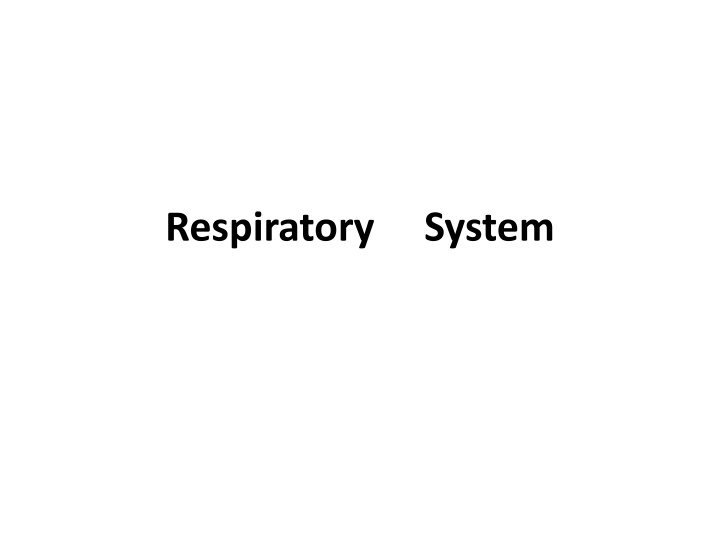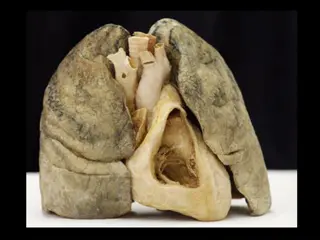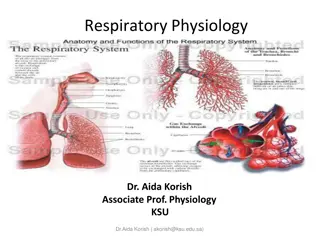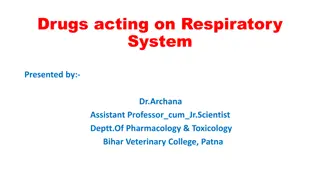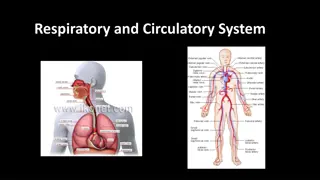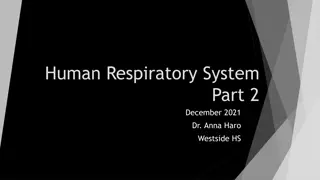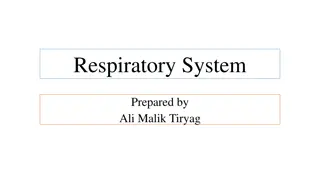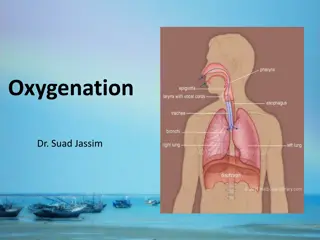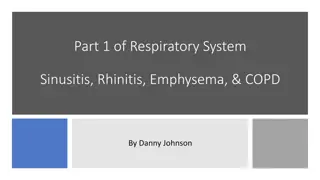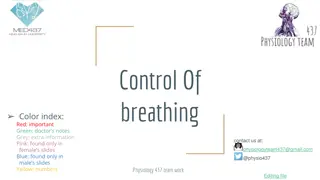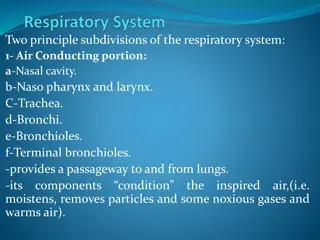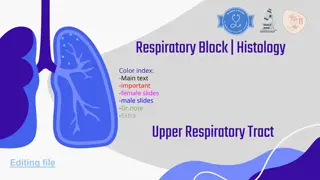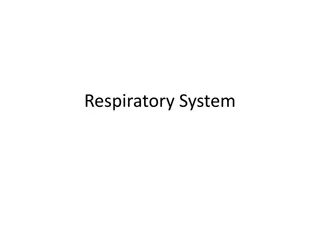Overview of Respiratory System Components and Functions
The respiratory system consists of vital components like pulmonary compliance and surfactant, crucial for proper lung function. Pulmonary compliance reflects the lung's ease of expansion, influenced by factors like lung elasticity and surface tension. Surfactant, produced by type II alveolar cells, reduces surface tension in alveoli, aiding in maintaining lung inflation and preventing collapse. Disorders like Respiratory Distress Syndrome can occur when surfactant levels are insufficient, particularly in premature babies. Understanding these components is key to appreciating the intricate workings of the respiratory system.
Download Presentation

Please find below an Image/Link to download the presentation.
The content on the website is provided AS IS for your information and personal use only. It may not be sold, licensed, or shared on other websites without obtaining consent from the author.If you encounter any issues during the download, it is possible that the publisher has removed the file from their server.
You are allowed to download the files provided on this website for personal or commercial use, subject to the condition that they are used lawfully. All files are the property of their respective owners.
The content on the website is provided AS IS for your information and personal use only. It may not be sold, licensed, or shared on other websites without obtaining consent from the author.
E N D
Presentation Transcript
Pulmonary compliance The ease with which lungs & thoracic wall can be expanded.( extent to which lung will expand for each unit increase in transpulmonary pressure. Compliant lungs are easy to distend. Compliance is determined by (2 factors in which compliance related: elasticity of the lungs and surface tension in the alveoli): - Elastic force which is caused by elastic tissues of the lungs (elastin and collagen fibers).It represents one third of the total lung elasticity. - Elastic force caused by surface tension of the fluid that lines inside wall of alveoli (caused by air fluid interface).It represents two thirds of total lung elasticity. 1. destroys the lung tissue (emphysema) 2 fills the lungs with fluid (pneumonia) 3. produces a deficiency of surfactant (premature birth, near-drowning) 4.interferes with lung expansion (pneumothorax) Compliance is decreased with any condition that:
Walls of alveoli are coated with a thin film of water & this creates a potential problem. Water molecules, including those on alveolar walls, are more attracted to each other than to air, & this attraction creates a force called surface tension. This surface tension es as water molecules come closer together, which is what happens when we exhale & our alveoli become smaller (like air leaving a balloon). Potentially, surface tension could cause alveoli to collapse and, would make it more difficult to 're-expand' alveoli (when you inhaled). Both of these would represent serious problems: if alveoli collapsed they would contain no air & no oxygen to diffuse into blood &, if 're-expansion' was more difficult, inhalation would be very, very difficult if not impossible. Fortunately, our alveoli do not collapse & inhalation is relatively easy because the lungs produce a substance called surfactant that reduces surface tension.
Pulmonary surfactant It is an essential lipid-protein complex formed by type II alveolar cells. Surfactant is present when the lungs are fully developed. Function: Surfactant decreases surface tension which: pulmonary compliance (reducing the effort needed to expand lungs) reduces tendency for alveoli to collapse This will helps lungs fill with air and keeps air sacs (alveoli) from deflating. Surfactant production is decreased by effect of smoking, & hypoxia increases by hormonal effect (insulin, thyroid hormone & glucocorticoid hormone).
Respiratory Distress Syndrome (RDS) It is a problem often seen in premature babies (whose lungs have not yet fully developed). The condition makes it hard for the baby to breathe. The disease is mainly caused by a lack of surfactant.
What is the oxygen dissociation curve? It is a graph that plots the proportion of Hb in its oxygen saturated form on vertical axis against partial pressure of oxygen on the horizontal axis. At high partial pressures of oxygen, Hb binds to oxygen to form oxyhaemoglobin. All RBC are in form of oxyhaemoglobin when blood is fully saturated with oxygen. At low partial pressures of oxygen (e.g. within tissues that are deprived of oxygen), oxyhaemoglobin releases oxygen to form Hb.
Which factors affect oxygen Hb dissociation curve? Can be shifted right or left by a variety of factors. A right shift indicates decreased oxygen affinity of Hb allowing more oxygen to be available to tissues. A left shift indicates increased oxygen affinity of Hb allowing less oxygen to be available to tissues. - pH - Temperature - CO2 - Organic phosphates (2-3 Diphosphoglycerate)
pH: A in pH shifts the curve to the right. an in pH shifts the curve to the left. This occurs because a higher H + conc. causes an alteration in amino acid residues that stabilises deoxyhaemoglobin that has a lower affinity for O2. This rightwards shift is referred to as the Bohr effect. Carbon dioxide (CO2): A in CO2 shifts the curve to the left, an in CO2 shifts the curve to the right. CO2 affects the curve in two ways. Firstly, accumulation of CO2 causes carbamino compounds to be generated, which bind to O2 & form carbaminohaemoglobin that stabilizes deoxyhaemoglobin. Secondly, accumulation of CO2 causes H+ ion conc & pH, which will shift the curve to right.
Temperature: An in temperature shifts the curve to the right, a in temperature shifts the curve to the left. Increasing the temperature denatures the bond between oxygen and Hb, which increases the amount of oxygen and Hb and decreases the conc of oxyhaemoglobin. Temperature does not have a dramatic effect but the effects are noticeable in cases of hypothermia and hyperthermia. Organic phosphates: 2,3-Diphosphoglycerate (2,3-DPG) is the main primary organic phosphate. 2,3-DPG shifts the curve to the right, 2,3-DPG shifts the curve to the left. 2,3-DPG binds to Hb & rearranges it, which es its affinity for O2.
How does CO affect the curve? CO interferes with O2 transport function of blood by combining with Hb to form carboxyhaemoglobin (COHb). CO has approximately 240 times the affinity for Hb that O2 does & for that reason even small amounts of CO can tie up a large proportion of Hb in blood making it unavailable for O2 carriage. If this happens PO2 of blood & Hb conc. will be normal but oxygen conc. will be grossly reduced. The presence of COHb also causes oxygen dissociation curve to be shifted to left, interfering with unloading of O2.
How does methaemoglobin affect the curve? Methaemoglobin is an abnormal form of haemoglobin in which the normal ferrous form is converted to the ferric state. Methaemoglobinaemia causes a left shift in the curve as methaemoglobin does not unload oxygen from haemoglobin.
